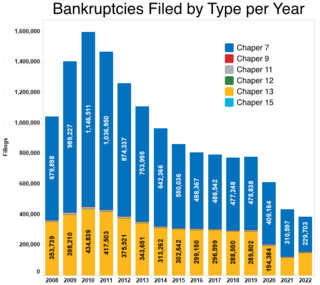Related Research Articles
Bankruptcy is a legal process through which people or other entities who cannot repay debts to creditors may seek relief from some or all of their debts. In most jurisdictions, bankruptcy is imposed by a court order, often initiated by the debtor.
Chapter 11 of the United States Bankruptcy Code permits reorganization under the bankruptcy laws of the United States. Such reorganization, known as Chapter 11 bankruptcy, is available to every business, whether organized as a corporation, partnership or sole proprietorship, and to individuals, although it is most prominently used by corporate entities. In contrast, Chapter 7 governs the process of a liquidation bankruptcy, though liquidation may also occur under Chapter 11; while Chapter 13 provides a reorganization process for the majority of private individuals.
Chapter 7 of Title 11 U.S. Code is the bankruptcy code that governs the process of liquidation under the bankruptcy laws of the U.S. In contrast to bankruptcy under Chapter 11 and Chapter 13, which govern the process of reorganization of a debtor, Chapter 7 bankruptcy is the most common form of bankruptcy in the U.S.

The Exchequer of Pleas, or Court of Exchequer, was a court that dealt with matters of equity, a set of legal principles based on natural law and common law in England and Wales. Originally part of the curia regis, or King's Council, the Exchequer of Pleas split from the curia in the 1190s to sit as an independent central court. The Court of Chancery's reputation for tardiness and expense resulted in much of its business transferring to the Exchequer. The Exchequer and Chancery, with similar jurisdictions, drew closer together over the years until an argument was made during the 19th century that having two seemingly identical courts was unnecessary. As a result, the Exchequer lost its equity jurisdiction. With the Judicature Acts, the Exchequer was formally dissolved as a judicial body by an Order in Council on 16 December 1880.

A debtors' prison is a prison for people who are unable to pay debt. Until the mid-19th century, debtors' prisons were a common way to deal with unpaid debt in Western Europe. Destitute people who were unable to pay a court-ordered judgment would be incarcerated in these prisons until they had worked off their debt via labour or secured outside funds to pay the balance. The product of their labour went towards both the costs of their incarceration and their accrued debt. Increasing access and lenience throughout the history of bankruptcy law have made prison terms for unaggravated indigence obsolete over most of the world.

In the United States, bankruptcy is largely governed by federal law, commonly referred to as the "Bankruptcy Code" ("Code"). The United States Constitution authorizes Congress to enact "uniform Laws on the subject of Bankruptcies throughout the United States". Congress has exercised this authority several times since 1801, including through adoption of the Bankruptcy Reform Act of 1978, as amended, codified in Title 11 of the United States Code and the Bankruptcy Abuse Prevention and Consumer Protection Act of 2005 (BAPCPA).

Distraint or distress is "the seizure of someone’s property in order to obtain payment of rent or other money owed", especially in common law countries. Distraint is the act or process "whereby a person, traditionally even without prior court approval, seizes the personal property of another located upon the distrainor's land in satisfaction of a claim, as a pledge for performance of a duty, or in reparation of an injury." Distraint typically involves the seizure of goods (chattels) belonging to the tenant by the landlord to sell the goods for the payment of the rent. In the past, distress was often carried out without court approval. Today, some kind of court action is usually required, the main exception being certain tax authorities – such as HM Revenue and Customs in the United Kingdom and the Internal Revenue Service in the United States – and other agencies that retain the legal power to levy assets without a court order.
A fraudulent conveyance or fraudulent transfer is an attempt to avoid debt by transferring money to another person or company. It is generally treated as a civil cause of action that arises in debtor/creditor relations, typically brought by creditors or by bankruptcy trustees against insolvent debtors, but in some jurisdictions there is potential for criminal prosecution.
Repossession, colloquially repo, is a "self-help" type of action, mainly in the United States, in which the party having right of ownership of the property in question takes the property back from the party having right of possession without invoking court proceedings. The property may then be sold by either the financial institution or third party sellers.
A bankruptcy discharge is a court order that releases an individual or business from specific debts and obligations they owe to creditors. In other words, it's a legal process that eliminates the debtor's liability to pay certain types of debts they owe before filing the bankruptcy case.
Actio personalis moritur cum persona is a Latin expression meaning "a personal right of action dies with the person".

The Bankruptcy and Insolvency Act is one of the statutes that regulates the law on bankruptcy and insolvency in Canada. It governs bankruptcies, consumer and commercial proposals, and receiverships in Canada.

Addison Gardiner was an American lawyer and politician who served as Lieutenant governor of New York from 1845 to 1847 and Chief Judge of the New York Court of Appeals from 1854 to 1855.
Attachment is a legal process by which a court of law, at the request of a creditor, designates specific property owned by the debtor to be transferred to the creditor, or sold for the benefit of the creditor. A wide variety of legal mechanisms are employed by debtors to prevent the attachment of their assets.
Toibb v. Radloff, 501 U.S. 157 (1991), was a case in which the United States Supreme Court held that individuals are eligible to file for relief under the reorganization provisions of chapter 11 of the United States Bankruptcy Code, even if they are not engaged in a business. The case overturned the lower courts ruling which restricted individuals to chapter 7.
Debt evasion is the intentional act of trying to avoid attempts by creditors to collect or pursue one's debt. At an elementary level, this includes the refusal to answer one's phone by screening one's calls or by ignoring mailed notices informing the debtor of the debt. In more advanced cases, this includes misleading the creditor to believe the debtor does not reside at the location where the creditor is attempting to reach the debtor.
Ransom v. FIA Card Services, N. A., 562 U.S. 61 (2011), is a decision by the Supreme Court of the United States involving the means test in Chapter 13 of the United States Bankruptcy Code. The means test had been adopted by the Bankruptcy Abuse Prevention and Consumer Protection Act of 2005, and Ransom is one of several cases in which the Supreme Court addressed provisions of that act.
Stern v. Marshall, 564 U.S. 462 (2011), was a United States Supreme Court case in which the Court held that a bankruptcy court, as a non-Article III court lacked constitutional authority under Article III of the United States Constitution to enter a final judgment on a state law counterclaim that is not resolved in the process of ruling on a creditor's proof of claim, even though Congress purported to grant such statutory authority under 28 U.S.C. § 157(b)2(C). The case drew an unusual amount of interest because the petitioner was the estate of former Playboy Playmate and celebrity Anna Nicole Smith. Smith died in 2007, before the Court decided the case, which her estate lost.
Civil procedure in South Africa is the formal rules and standards that courts follow in that country when adjudicating civil suits. The legal realm is divided broadly into substantive and procedural law. Substantive law is that law which defines the contents of rights and obligations between legal subjects; procedural law regulates how those rights and obligations are enforced. These rules govern how a lawsuit or case may be commenced, and what kind of service of process is required, along with the types of pleadings or statements of case, motions or applications, and orders allowed in civil cases, the timing and manner of depositions and discovery or disclosure, the conduct of trials, the process for judgment, various available remedies, and how the courts and clerks are to function.
Insolvency in South African law refers to a status of diminished legal capacity imposed by the courts on persons who are unable to pay their debts, or whose liabilities exceed their assets. The insolvent's diminished legal capacity entails deprivation of certain of his important legal capacities and rights, in the interests of protecting other persons, primarily the general body of existing creditors, but also prospective creditors. Insolvency is also of benefit to the insolvent, in that it grants him relief in certain respects.